We rented a car this morning and set off to explore Grande Terre. This half of Guadeloupe is low and mostly flat, a big contrast to the imposing mountains on Basse Terre. We followed the main highway east and somehow missed the exit that would take us into Gosier. According to Lonely Planet, Gosier is the main tourist area of Guadeloupe and quite built up with endless hotels. Since we had already seen a little bit of Gosier and it didn’t sound that great anyway, we decided not to backtrack.
Instead we pressed on to a town called St. Anne’s, about halfway down the southern shore. The scenery between Point a Pitre and St. Anne’s is farmland with a scattering of houses about. Most of the houses are the colorful bungalows with metal slanted roofs and gingerbread trim. These farms look more like the kind of crops that have to be planted annually, whereas on Basse Terre most of the farmland had trees/bushes that bloom year in and year out. From what we could see, St. Anne’s was tiny. Like Deshaies, it is only a few blocks big. But, it is a cute beach community nestled along a scenic bay. There were several boats anchored in the bay. The part of the bay on the outskirts of town looked to be super protected, and the boats closer in to town seemed to be rolling a lot in the swells.
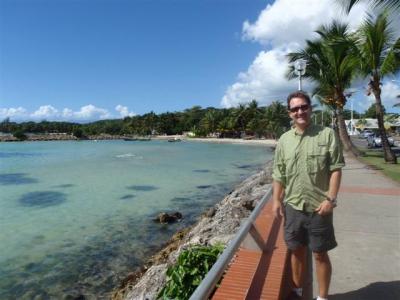
We stopped to go into a craft market on the eastern edge of town. We expected it to be all the usual tourist stuff. We were surprised at the high quality art work we found inside. It is truly some of the most unique and creative art work we have seen. There were a lot of especially cool sculptures made from coconut shells, including animals, piggy banks, faces, ash trays and lamps. The lamps are amazing, shaped like little trees and animals, with small holes cut into the shells to let out the light. We have seen some pretty cool coconut sculptures in other places in the world before, but the artwork here definitely wins for best we have seen so far in the world. There was also some unique sand art. They make animals and other figures out of packed sand (they must use a mold), then put some kind of coating or glaze around the figure so it all stays together. In and amongst the sand are decorative small shells that enhance the figure, like shells for eyes. There were some great masks, too. Most of the rest of the art used more conventional mediums, such as wood sculpture and canvas paintings, but were just as striking. The artistry styles definitely reflect the country’s roots. There are some artists whose style is reminiscent of Native American Indians, some reflect East Indian (meaning from India) styles, many have a strong African feel to them, and most are a melding of western with the indigenous.
As a side note, we have learned that oftentimes pieces of art “hand made by the locals” were really made in Indonesia and imported. We’re not criticizing the quality of work — Indonesia has incredible artisans, but we are somewhat leery of things that look at all reminiscent to what we saw in Bali. We didn’t see anything in Bali that looked like this stuff, so it may genuinely be made by the local artists.
Anyway, in addition to artwork, they sold a variety of local made flavored rums, food products, soaps, and so forth.
We continued down the coast to the town of St. Francois, which is at the eastern end of the island. It is noticeably bigger than St. Anne’s, but still a small town. They have a marina there, so we went to check it out. It is similar to the marina in Point a Pitre, a large, modern complex with lots of amenities. We kind of wish we stayed here. This seems like the kind of place you can wander town freely at any hour of the day or night with no concerns for your safety. And it smelled good.
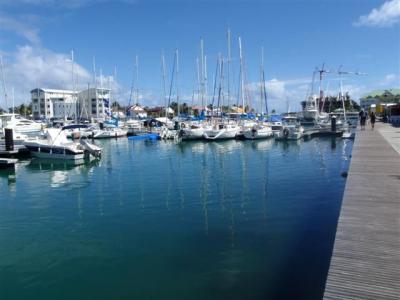
From St. Francois, the main road heads north, but there is a small road that takes you east down a narrow peninsula to the easternmost point on the island. Along this little road is a place called the “House of Coconuts”, which sounded intriguing to us, so we stopped in. It turned out to be another artisan shop that carried a similar variety of art work to what we had seen in St. Anne’s. Although, this place has some larger pieces to choose from, and some of the unique big pieces includes an elaborate sink pedestal with a large iguana watching you wash your hands.
We continued on to the Point de Chateaux, which is the end of the road. There was no sand here — the shoreline is a rocky ledge. It was low tide, and we waded along the rocks out to the Point de Colibris, the very edge of the island. There are nice views of some small islets around the edge.
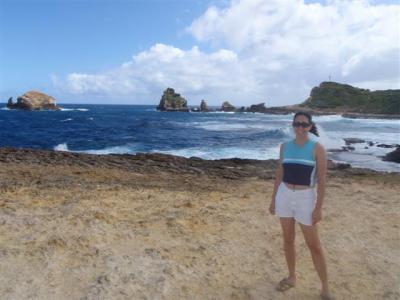
Several vendors had set up shop there with folding tables. Most were selling small handicrafts like what we had seen in the shops, but a couple of them were selling hand made soft ice cream. The vendors each had old fashioned hand crank ice cream makers. Today’s flavor choices were coconut or passion fruit, and after sampling both, we went with the coconut. We wandered over to a ledge to enjoy our treat and while we were standing there, the weirdest thing happened. A small cloud floated up above us and it started to rain. We were getting ready to make a run for the car when we realized that it was only raining on us and no one else was getting wet. So, we just made a beeline for the edge of the cloud, instead.

We went back to St. Francois and headed north to the town of Le Moule, about halfway up the east coast. The road was farther inland, and like the south coast, it was mostly farmland and some scattered residential. Le Moule was an important Native American settlement in pre-colonial times and the original French capital of Guadeloupe. Today it is a sleepy little beach town with some historic buildings in the town center. There is a large town square with a big, distinctly French style neo-classical church, but the majority of the town is made up of small, more modern buildings with that same mix of well kept and weather beaten seen on the rest of the island. We did stop by the beach there and went for a short walk on the sand. It is supposedly a surfer’s paradise, and from what we could tell, it did look like good surfing waves. There is a brand new looking gated community of identical big, two story tract homes on tiny lots right on the water near where we were walking around.
Le Moule was as far north as the main road went, so we took another smaller road marked on the map. We found out that the non-main roads around here are unpaved, quite bumpy, and lack signs at intersections. After about 20 minutes of driving through endless farmland, we realized we were lost and headed back to the main road. The main road took us due west back to the west coast of Grande Terre, ending at a town called Morne L’eau. It is another small, weather beaten town with a nice town square. Its crowning glory is its elaborate cemetery, filled with black and white checkered tile mausoleums. We did a drive by of the cemetery, but didn’t go in.
From there we turned north and headed to the town of Anse Bertrand, located on the north coast. The area in between the two towns is still all farmland, but up here there are more sugar cane fields than any other type of crop. The first picture is what the scenery around most of the island looks like. The second gives you an idea of what many of the houses look like, at least in terms of brightly colored, metal roofed, and gingerbread trim. The layouts amongst the houses vary.
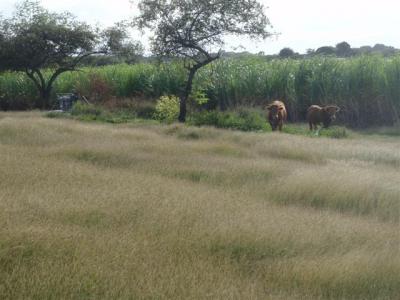
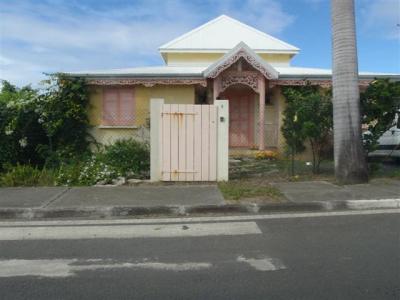
On a random side note, we have seen a lot of cows around Guadeloupe. There are almost always white birds hanging out in the fields with them. It is usually a 1:1 ratio of birds to cows. The birds just stand contentedly next to the cows and watch them graze. They make an odd duet and it fascinates us.
Anyway, in Anse Bertrand we stopped by a pretty beach for a little bit. Then we drove around the town some. The majority of the coastline is rocky, with violent waves crashing into the shore. The town itself looks better than most of the other surrounding towns, with a nice park, a small bay for flat bottomed boats, and overall better maintained buildings. We were searching for a restaurant that had been recommended to us, but never found it. We decided it was just as well, since there was absolutely nothing to do in this town and we wouldn’t know what to do with ourselves until the restaurant opened at 2000.
We headed back south past Morne L’eau to Point a Pitre. Throughout the day, we did pass a few more towns that we didn’t mention, but they were so little that they looked to be nothing more than a small cluster of buildings congregated along the side of the road. There was no industrial activity of any kind that we noticed. Also, we noticed no undeveloped land at all. It all looked to be actively used as farms or residences, which contrasts sharply with Basse Terre, which seemed to have a lot of undeveloped land outside the national park, especially higher up in the hills. It looked like most of the fields of crops had been recently ploughed and planted and they were waiting for the new plants to emerge. We did see a field of young plants that we think are taro.
In the evening, we decided to go back to the wonderful restaurant in downtown. We had a car and there was a parking lot near enough to the restaurant that we didn’t have to really walk around. We headed north from the marina on that road that connects Victory Square and the marina. Just as we suspected, after dark the entire road is lined with hookers and other shady characters. We were so disappointed to see the restaurant was closed today. Bummer. We got back in the car and consulted Lonely Planet for other restaurant suggestions. Lonely Planet mentioned a place in Gosier that had “divine” food. We decided to go there. After all, we had missed Gosier earlier today, so we could complete our tour of the island.
The restaurant was in the heart of downtown Gosier. Gosier kind of has the same feel as St. Anne — safe, small, slightly run down beach community. The line of hotels is outside downtown, and we are sure the more touristy section is new and modern. We made a couple loops through town before we found the restaurant. It is a converted plantation style house and the décor is cute. Sadly, we had bad timing, arriving right behind two large parties. The restaurant was absolutely packed, which we took as a sign that the food really was “divine”. There were only two waitresses, so service was slow, but it was OK, we would patiently wait for “divine” food. We were surprised when we looked at the menu to see this was probably the highest price place we have been to yet. Since we weren’t paying for good views, this must mean the food is extra great. Then the food came. We got a fish and a chicken dish. They were both rather plain, with an unexceptional sauce, and were served with plain rice and a plain salad. The portions were regular size, not the big portions we have become accustomed to. We were so disappointed. Where were the complex French sauces? Where were the yummy exotic side dishes? How could this possibly be the most expensive restaurant yet when it had the smallest portions and most mediocre food? And why was it packed? Lonely Planet rarely lets us down, but this time it did. And, interestingly, the wonderful restaurant downtown, the one that is supposedly the best in the Caribbean, was not mentioned in Lonely Planet at all. The author is clearly not a foodie.

Some times Lonely Planet gets ,it wrong